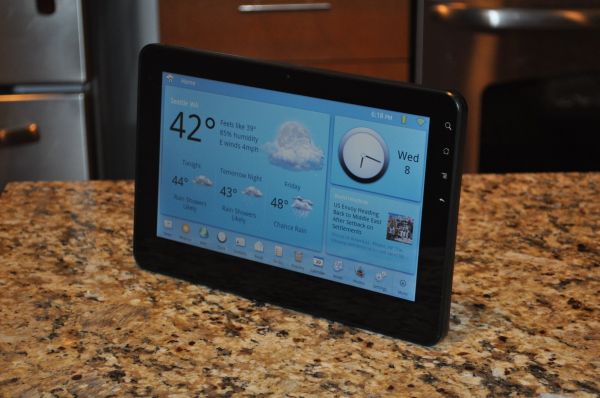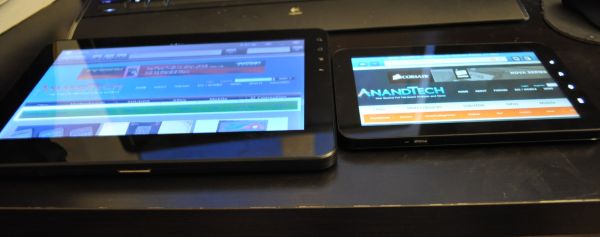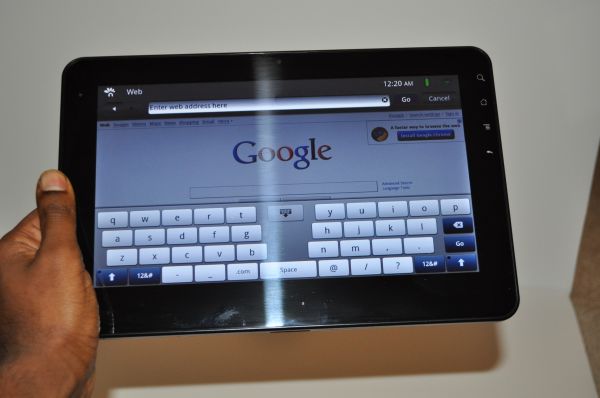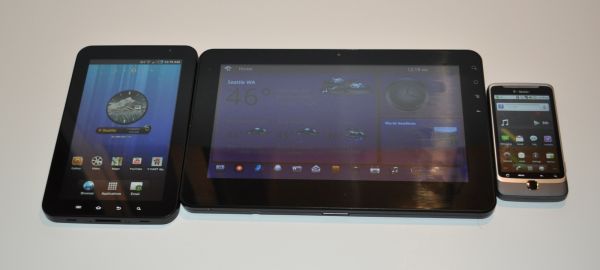First Look: Viewsonic G Tablet and Tegra 2 Performance Preview
by Vivek Gowri on December 9, 2010 3:04 AM ESTThe slate computing market is about to explode, with a literal flood of new tablets releasing over the coming months. Many of them will be Android based, running Nvidia’s Tegra 2 SoC. Nvidia made a big deal about Tegra 2 back at CES 2010, but for some reason, it’s taken quite a bit of time for anything running the platform to hit the market. Finally, we have one - the Viewsonic G Tablet.
The Tegra 2-based Viewsonic G Tablet showing the Tap UI homescreen
The specs are pretty straightforward; we’ve got a 10” WSVGA display with LED backlighting, Android 2.2 with a specialized UI skin on top, a 16GB microSD card, 2.4GHz 802.11n, Bluetooth 2.1, a 27 Whr lithium ion battery, and the Tegra 2 SoC. The dual-core Cortex A9 is clocked at a nice, round 1 GHz, and there’s 512MB of LPDDR RAM on board. The GPU is Nvidia’s Ultra-Low Power GeForce GPU and there are separate HD video encode and decode blocks also onboard. But the big deal with Tegra 2, as Anand went over in his first look at the SoC, is Cortex A9. The A9 is an out of order architecture with a relatively short pipeline, so it should be significantly faster than the in-order A8 on a per-clock basis.
But before we get to the performance aspect, let’s give the tablet a once over. The Viewsonic is not the most interesting physical specimen, just a screen with a thin bezel around it. From the front, it looks nearly identical to the Galaxy Tab and any number of other tablets on the market. The sides are pretty plain, with volume buttons at the top and a dock connector and mic at the bottom. The left side has a mini USB port, a headphone jack, and a power jack, while there are speakers on either side. The back is filled with logos - Viewsonic, the gTablet logo, the American distributor’s logo, barcode, FCC ID, etc - but otherwise pretty plain. Build quality is actually pretty decent and the tablet has a pretty weighty feel in hand. There’s no flex anywhere, and while the casing doesn’t feel particularly high quality, it’s not low quality by any means. There are some touches in the industrial design that make it seem a bit cheap. The capacitive touch buttons are off-center and easy to press inadvertently, and the physical buttons are placed pretty haphazardly. One thing that really threw me off is the volume rocker, which is switched from the logical layout (volume up is the lower button, volume down is the upper button).
The Viewsonic (left) next to the Samsung Galaxy Tab, both on maximum brightness, to illustrate the viewing angles of both tablets
But for $399 for a Tegra 2 tablet, minor quibbles about build quality and industrial design are about what one should expect. I also expected a not-so-great screen, but not like this. I know that not everyone can splurge like Apple did and go for an IPS screen, but when you look at the TN panels in these and other tablets, it really does make sense. The problem isn’t contrast ratio, the 432:1 figure is actually pretty good for a netbook screen and much better than most small notebooks. It doesn't match the iPad's amazing 934:1 contrast ratio, but still, contrast is not the problem. Unfortunately, the max brightness is not that high at 186nits, which only exacerbates the terrible viewing angles. Something I’ve realized in using tablets - the viewing angles matter a whole lot more than they do in laptops. As is typical with widescreen displays, the horizontal viewing angle is decent, but the vertical viewing angle is pretty bad - anything more than 30 degrees off center and the screen completely washes out. If I try to lay it flat on my desk and use it like my iPad or the Galaxy Tab, it’s basically impossible to see anything on the screen. For a device with a usage model so heavily dependant on good off-center viewing angles, speccing a screen with poor viewing angles was a pretty big oversight.
Viewsonic's Tap UI landscape split keyboard in the revised browser interface
Viewsonic loaded their own Tap UI onto the G Tablet. It’s a decent looking UI, but it’s aggravatingly slow and makes most of the navigation through the OS pretty painful. As with most tablets, there’s no Market preinstalled on the G Tablet (Samsung is the exception here, since they have managed to work around the Android Market restrictions). However, the XDA developers forum is your friend - there’s a simple workaround to get Market and other Google applications enabled, and it’s also possible to disable the UI skin. We’ll go over the software package and hacking aspects of the G Tablet in the full review; for now just know that the preloaded UI is pretty terrible, you'll want to disable it as soon as possible.
The G Tablet (center) next to the Galaxy Tab (left) and T-Mobile G2 (right)
Our first impressions of the G Tablet, beyond the woeful viewing angles and the unfortunate UI skin, is actually that of a fairly usable budget tablet. The user experience is actually pretty decent once you get out of the main UI and into an app or a browser window, and the split keyboard in landscape mode is much better than expected. The tablet has a nice, weighty feel in hand, but if you're using it in landscape mode, it might feel a little heavy for one-handed operation. The touchscreen is responsive enough, though it doesn't feel quite as sensitive as the Galaxy Tab or the iPad. That could just be because of the overall sluggishness of the UI, but we'll see about that after I load the stock Android UI onto the G Tablet. We'll see, but at first brush it looks like the main problems with the Viewsonic are the screen and the UI. We'll have a full review later on with more complete impressions and battery life numbers, but for now, we'll leave you with a preview of Tegra 2 performance.




















78 Comments
View All Comments
VivekGowri - Friday, December 10, 2010 - link
Guys, this is AnandTech, not the Merriam-Webster forums. Seriously. Though, I do appreciate the fact that unabridged dictionaries support my metaphorical usage of the word flood.I still like the "tablets being shipped to my door via tidal wave" idea though, that sounds like fun.
therealnickdanger - Tuesday, December 14, 2010 - link
Will you be surfing on said tidal wave? LOLdigitalzombie - Friday, December 10, 2010 - link
I love your critiques, it's very honest. I'm waiting for a handon review on the Ink Notion to see if the build quality is up to snuff before I buy it that and waiting for tegra 2 perhaps. I also love the tadbit on the IPS screen of Apple. I've seen a lot of people complaining about how much the iPad cost but I never see a good hardware remark that can some how justify the expensive price...until now.Anyway, thanks for the review! Anandtech is the only gadget blog I trust entirely ^_______^.
MentorSage - Friday, December 10, 2010 - link
The Norton Ink looks like the tablet to get. It's definitely the most innovative and uses a Pixel Qi Transflective liquid crystal display & Nvidia Tegra 2.http://www.youtube.com/watch?v=WxgRBC47SAo
GnillGnoll - Friday, December 10, 2010 - link
Vivek,Is it possible to get some more details on how the benchmark results were measured? E.g. which OS version was each device running, which benchmark version/build was being used, any benchmark specific settings?
Was "Quake III Arena" actually kwaak3 or some other Android port? And which timedemo and quality settings did you use?
nanosec99 - Friday, December 10, 2010 - link
I purchased the G-Tablet about a week ago for $379 from Sears. I really didn't know what to expect, because I've never had the opportunity to use a tablet before.I currently own a Nexus One. I am very happy with it, and with the Android OS.
When I saw that the G-Tablet came with 2.2 version of Droid, I just had to have it. The author is correct. The UI that Viewsonic stuck on it is fairly easy to use. I do like it, but it does make the tablet seem less responsive. I will more than likely flash my G-Tablet to run the native droid 2.2 without the Viewsonic UI. Most of the forum posts I have read state users enjoying the tablet even more after flashing the OS.
As far as the viewing angle is concerned; it really didn't bother me that it has a limited viewing angle because I don't use the tablet laying flat on a table. I normally just hold it in my hands.
I installed Flash last night. (It is a little slow, but works ok) I play Zynga poker for an hour or so. I've installed the Kindle application and have been reading one of my books. It makes a decent e-reader plus you can still surf the web and play games.
I have no regrets with my purchase and look forward to tinkering with it in the future.
I know iPad owners will say that the iPad is better. (I do like Apple products) I just hate that Apple locks down their OS. My thinking… If you pay $500-800 for a product, you should be able to do anything you want with it. Just my 2 cents!
melgross - Saturday, December 11, 2010 - link
You can always jailbreak it if you really want to. That's not much different from what some people here are doing to this to get it to work better.MonkeyX - Sunday, December 12, 2010 - link
The viewing angle "issue" is a plus to me when you think about privacy.batmanuel - Sunday, December 12, 2010 - link
In its stock form, it's basically unusable. The UI is incredibly laggy, and with no Market you can't download the apps you really need to make it shine. It really takes an Android hacker to make this device work. For regular consumers, it is a big bag of fail that is going to be a lump of coal in the stocking of anyone who receives this as a gift. The Galaxy Tab and iPad are an order of magnitude better than this device out of the box.The only bright side is that these are almost certain to be clearanced out for cheap sometime in January, so those of us who want to hack this into usability will probably be able to for $200 or less in a couple of months.
TareX - Sunday, December 12, 2010 - link
Thanks for including the Quake III results. I too, have read the Hummingbird's GPU "easily" destroys the Geforce ULP Nvidia chose for Tegra 2, I think the source of this rumor is this guy: http://smartphonebenchmarks.com/forum/index.php?/t...Comparing the Tegra 2 to Orion, he says:
"Tegra 2's CPU core will be competitive but its GPU appears to be weaker than even PowerVR SGX540. Heck, even Qualcomm's Adreno 205 may outperform this GPU. On the plus side, Tegra 2 is already available on the market NOW, and smartphones based on Tegra 2 will appear during Q4 of 2010. (Read this article for more details on Tegra 2). Samsung, LG and Motorola have announced their intention of producing phones based on Tegra 2 so far."
How depressing. I'm glad it wasn't true.
However, I'm quite disappointed that you hadn't managed to mention the battery-friendliness of Tegra 2... That was the main reason why I would get a Tegra 2 phone instead of an Orion one. Orion seems to have a crazy fast GPU, that isn't battery friendly.
If Tegra 2 can accelerate 1080p HD flash embedded in the browser without a hiccup (as shown in numerous youtube videos), I don't really think I'll ever need Samsung's crazy fast GPU (which they said was 5x faster than Hummingbird's GPU).